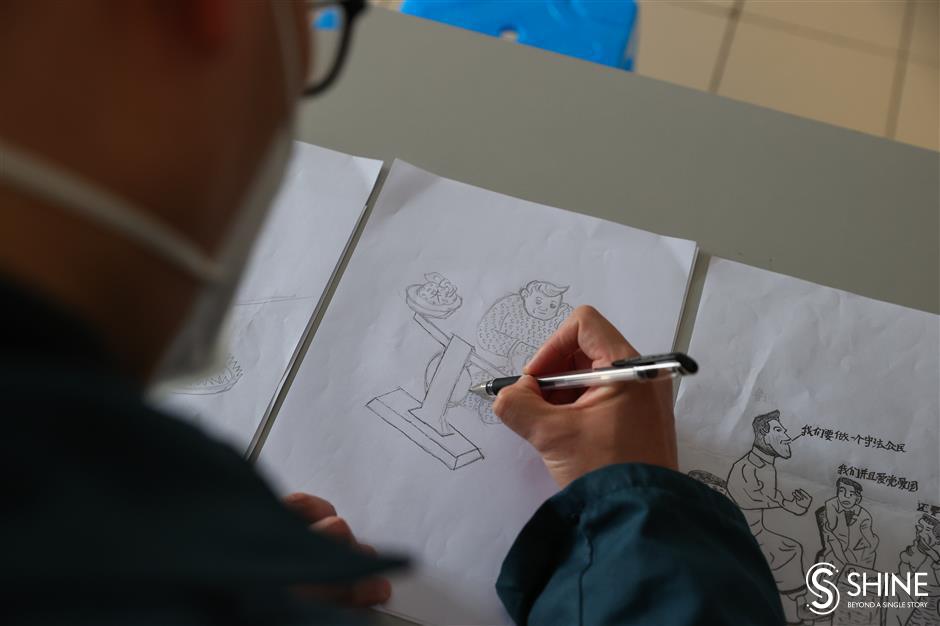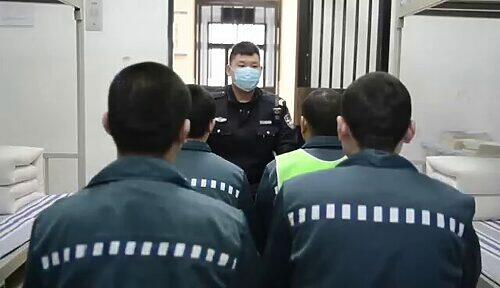Editor's Note:
Artificial intelligence is scaring some of us into thinking we may lose our jobs to automatons. Are there jobs that digital technology simply can't replace, at least in the foreseeable future? This series explores careers where humans have a leg up on machines.
Shot by Zhou Shengjie. Edited by Zhong Youyang. Subtitles by Zhong Youyang and Tian Shengjie.
Du Peng, a police officer and psychology consultant at Shanghai Wujiawa Prison, looks compassionately at the prisoner sitting across from him. "Why did you try to scald your arm with boiling water?" he asks.
The prisoner, surnamed Zhang, doesn't answer, only shakes his head. Silence ensues.
"You picked a fight with other inmates two days ago because of the placement of wash basins, right?" Du asks, trying to get a reaction.
Again, Zhang shakes his head and avoids eye contact. So, the psychologist adopts a different tack.
"I understand your daughter is sick and took a turn for the worse recently," he says.
Tears well in his eyes as Zhang finally looks at Du and speaks. He explains that he has been at the end of his tether since learning of his daughter's condition on the monthly phone call home.
Du arranges for the prisoner to have more frequent home calls during this trying time.
Du is part of a group of psychologists who work behind bars, providing counseling for inmates. The job requires patience, compassion, personal interaction and that human touch if the therapy is to work as part of rehabilitation.

Jiang Xiaowei / SHINE
Du Peng, a police officer and psychological consultant at Shanghai Wujiawa Prison, analyses the inner world of a prisoner and tries to help him relieve tension and stress via sandplay therapy.
The Shanghai Prison Administrative Bureau last year issued regulations requiring new prisoners to undergo psychological testing, with updates every two years. Those who show abnormalities are of greatest concern.
"Some prisoners have psychological problems before they are even arrested, and the strict regime of prison can aggravate the condition," said Gu Aijun, deputy director of Wujiawa prison, which houses hundreds of male prisoners with terms of three to 10 years.
"During a long term of incarceration," Gu added, "inmates are likely to experience misfortunes, such as divorce and deaths in families. That can lead to psychological distress."
The concept of psychology behind bars is to maintain stability in prisons and try to prevent criminals with mental problems from harming society again upon their release. That task falls to a dedicated group of trained psychologists.
In 2000, Shanghai prisons started to attach importance to the psychological needs of inmates, expanding recruitment of psychology graduates and providing training to prison officers interested in entering the field.
"At present, there are more than 700 prison officers with national psychology counselor certificates," said Wang Weiming, an official in the reform and education department of the local prison administrative bureau.

Jiang Xiaowei / SHINE
A convict settles his nerves through music therapy under the guidance of a police officer with psychology certificates in Shanghai Wujiawa Prison.
Du, 29, is one of them. He passed the national exam for psychology consultants while at university. After a psychology facility was established in Wujiawa's Cell Block I in 2017, he went to work there.
"Some prisoners are not aware they have psychological problems," Du said. "And even if they are aware, it's not something they are willing to share with others."
What psychologists may learn in classrooms and what they find in the prison setting are often worlds apart.
Xu Dong, director of the Psychology Health Guidance Room in Yangpu District's Wujiaochang prison, graduated in 2004 with a bachelor's degree in psychology and became a prison officer.
He had to cope with the gap between theory and reality, learning some bitter lessons along the way.
Xu told Shanghai Daily of an incident that happened soon after he went to work in the prison. An inmate surnamed Wang was reported to be crying at night. Xu immediately offered psychological counseling to him. But after talking to him for 40 minutes, he found Wang wearing a persistent smile and showing no signs of abnormal behavior, so he was allowed to go back to his cell.
However, the next day, Wang hit the prison iron door with his head in a fit of anger. Xu eventually learned that Wang had conflicts with his cellmate. After Wang was moved to another cell, his psychological condition gradually returned to normal.
The incident, according to Xu, made him realize how important it is to build trust with prisoners and persuade them to open up and talk.
"If an inmate refuses to open his heart to you, the psychology session will be hollow, even false," Xu said.

Jiang Xiaowei / SHINE
A prisoner releases his negative emotion in the Psychological Venting Room in Shanghai Wujiawa Prison.
Part of that trust means getting inmates to distinguish between prison guards who enforce discipline and psychologists who try to establish a more "equal footing" with prisoners.
To that end, psychology consulting rooms in prisons have been decorated in warm tones. The chairs are all the same, giving the inmate more of a feeling of equality and respect.
Sometimes, psychologists are rotated in the hope that a "new face" might help inmates lower their guard and open up, Du said.
Xu said he always changes from his police uniform for psychology sessions.
The professional therapy rooms in Shanghai prisons are designed for different functions such as music, sandplay and anger management. Group sessions are held regularly.
When Wujiawa prison opened in 2015, it was the first to introduce psychological cartoons for diagnosis and treatment.
"In psychology, there is a test called House-Tree-Person," said Huang Tengda, director of its psychological health guidance room. "It involves people drawing the three elements on paper. Then psychologists interpret the drawings and base treatment on that analysis. It's a good way to delve into a prisoner's inner thoughts."

Jiang Xiaowei / SHINE
A criminal draws psychological cartoons with different themes at Shanghai Wujiawa Prison.
Huang cited the example of an inmate who drew a windowless house and a bare tree. His renderings were interpreted to show that he was locked in a world of his own, suffering from a feeling of hopelessness.
In the picture, the inmate also drew a man standing under the tree with a knife. During the psychology sessions, the convict told him that his parents divorced when he was very young and the grandfather who raised him had recently died.
Huang said the sessions helped the inmate come to terms with his negative emotions and control them.
A prisoner surnamed Wu told Shanghai Daily: "I like drawing psychological cartoons with different themes, like greed, the desire for a future life and introspection on the crimes I committed. It's a form of catharsis."
The inmates' drawings have been published in books for sharing around the prison.
Indeed, sometimes the best therapy occurs when prisoners help one another with psychological problems. Each cell block has two "psychological helpers" – inmates with an upbeat disposition and excellent communication skills – who watch for abnormal behavior.
If they spot a problem, they first try to talk to the inmate, then pass on the information to a prison psychologist if necessary. Sometimes, psychiatrists are brought in to prescribe drugs for serious cases.

Ti Gong
A prisoner releases his negative feeling through virtual reality treatment at Shanghai Wujiaochang Prison.
In 2021, virtual reality therapy was introduced into Wujiaochang prison as a pilot project, starting in a cell block where inmates were about to be released. The technology allows prisoners to experience calming environments, like walking by the seaside.
As release from prison looms, many inmates feel uncertainly about moving back into society and worry about their futures. That anxiety was showcased in the character of Brooks Hatlen in the movie "The Shawshank Redemption." Hatlen was imprisoned for so long that jail became his real home. After his release, he committed suicide because he couldn't adjust to life on the outside.
The film reflects reality, Xu said. "Believe it or not, some prisoners don't even know what mobile phones are," he said.
To ease their release anxiety, virtual reality devices simulate job interviews and the opportunities of occupations such as deliveryman and shop assistant.
"I hope that various schools of psychological treatment, such as psychoanalytic therapy and cognitive behavioral therapy, will be like a hundred flowers blooming behind these high walls," said Wang of the prison administrative bureau.















